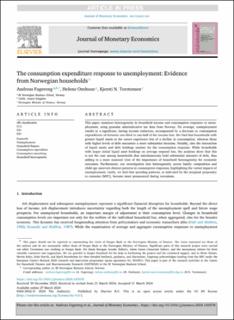The consumption expenditure response to unemployment: Evidence from Norwegian households
Journal article, Peer reviewed
Published version
Permanent lenke
https://hdl.handle.net/11250/3128178Utgivelsesdato
2024Metadata
Vis full innførselSamlinger
Originalversjon
10.1016/j.jmoneco.2024.103578Sammendrag
This paper examines heterogeneity in household income and consumption responses to unemployment, using granular administrative tax data from Norway. On average, unemployment results in a significant, lasting income reduction, accompanied by a decrease in consumption expenditures of between one-third to one-half of the income loss. We find that households with greater liquid assets at the outset experience less of a decline in consumption, whereas those with higher levels of debt encounter a more substantial decrease. Notably, also the interaction of liquid assets and debt holdings matters for the consumption response. While households with larger initial liquid asset holdings on average respond less, the analyses show that this is not the case among households that simultaneously hold substantial amounts of debt, thus adding to a more nuanced view of the importance of household heterogeneity for economic outcomes. Furthermore, our investigation into heterogeneity across family composition and child age uncovers distinct patterns in consumption responses, highlighting the varied impacts of unemployment. Lastly, we find that spending patterns, as indicated by the marginal propensity to consume (MPC), become more pronounced during recessions.

